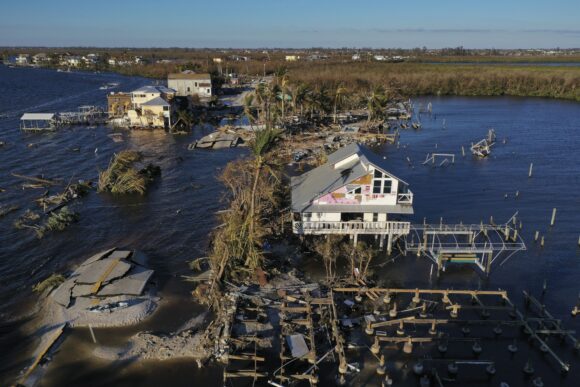The cost of the climate crisis keeps going up.
In terms of damage to the atmosphere and life on Earth, this may seem obvious. But the overall price tag of global warming has long been the subject of debate. Now, new data from Bloomberg Intelligence has put a number to the cost of burning fossil fuels.
It’s averaged about $500 billion a year since 2016. That’s equal to about 2% of US gross domestic product, according to Bloomberg Intelligence senior ESG climate analyst Andrew John Stevenson. Those figures represent the combined expenses from property damages, power outages, government spending and construction-surge inflation at the state level, he says.
For broader context, the estimated financial damages related to global warming have totaled almost $7 trillion over the past 30 years, Stevenson says. And this tally excludes things like lost wages tied to wildfires or extreme heat, as well as rising property-insurance premiums.
While certainly a sober reminder of the destruction wreaked by humanity, Stevenson notes there’s another way to look at the financial impact of the climate crisis. “Climate-related spending has made up 32% of GDP growth since 2016,” he says. Climate events are “a growing, visible part of the US economy, creating tailwinds for a few companies.”
Stevenson acknowledges, of course, that such disasters create “headwinds for the overwhelming majority of individuals, companies and the government.”
Stevenson has introduced what he calls the BI Climate Damages Tracker, to help investors calculate the economic impact—in either direction—of severe weather. Everything from the emergence of new businesses and changes in household spending to consumer credit and insurance risks.
The tracker is updated monthly with government and insurance data to estimate how the climate crisis is affecting public and private sector spending.
Investors have been diverting more funds to companies such as Aon Plc, Quanta Services Inc. and Home Depot Inc. because they’re among those that help businesses and homeowners clean up after the last storm and prepare for the next one, Stevenson says.
The analyst tracks storms that cause damages of less than $10 billion, as well as those that cost more than $10 billion. It’s the smaller events that have historically forced insurers to retain more losses on their balance sheets, Stevenson says. The three states that have traditionally been hit the hardest in that regard are Texas, Florida and Louisiana.
Fallout from climate events tends to be highly inflationary at both the local and national levels, as goods and services are diverted to meet the immediate needs of affected areas, Stevenson says. The BI Repair Sector includes 37 companies that are focused on storage, rentals, waste removal, building products, materials and construction and heating, ventilation and air conditioning (HVAC) services.
The average stock in the group, which includes Home Depot and Waste Management Inc., outperformed an equal-weighted S&P 500 by 96% on “a total-return, beta-neutral basis” over the past 10 years, Stevenson says.
For example, shares of Advanced Drainage Systems Inc. almost quadrupled since the first half of 2020 at the same time the company’s revenue almost doubled, partly due to the rising amount of flooding near rivers and coastal cities. Advanced Drainage makes storm-water management and drainage systems.
And then there’s the BI Prepare Sector, which includes 40 companies involved in mitigating risks related to supply-chain disruption, heat stress, wildfire pollution and infrastructure planning. This group, which includes Aon, MSA Safety Inc. and Dycom Industries Inc., exceeded the equal-weighted S&P 500 by 107% in the same 10-year period, according to the analyst’s calculations.
Other surprising beneficiaries of a warming planet are payday lenders like World Acceptance Corp. and FirstCash Holdings Inc., Stevenson says. Climate events cause significant short-term, high-cost spending that aren’t included in the budgets of most Americans.
The result is people turn to “alternative lenders” to avoid larger future bills, he says. “After all, the money has to come from somewhere.”
Top photo: In this aerial view, wreckage left in the wake of Hurricane Ian is shown on the island of Matlacha on September 30, 2022 in Matlacha, Florida. The Category 4 hurricane brought high winds, storm surge and rain to the area causing severe damage. (Photo by Win McNamee/Getty Images)
Was this article valuable?
Here are more articles you may enjoy.


 NYT, Chicago Tribune Sue Perplexity AI as Copyright War Rages On
NYT, Chicago Tribune Sue Perplexity AI as Copyright War Rages On  Truckers Who Fail English Tests Get Pulled Off Roads in Trump Crackdown
Truckers Who Fail English Tests Get Pulled Off Roads in Trump Crackdown  OpenAI And Microsoft Sued Over Murder-Suicide Blamed on ChatGPT
OpenAI And Microsoft Sued Over Murder-Suicide Blamed on ChatGPT  Standard Chartered Settles $2 Billion Iranian Sanction Suit in London
Standard Chartered Settles $2 Billion Iranian Sanction Suit in London 